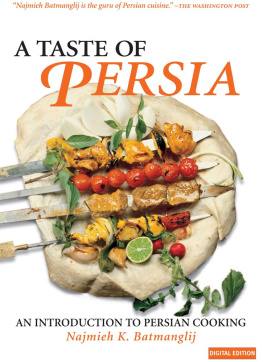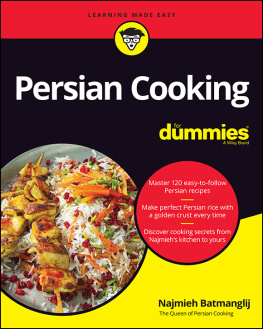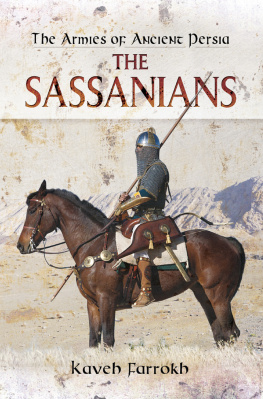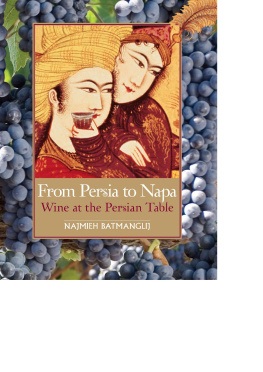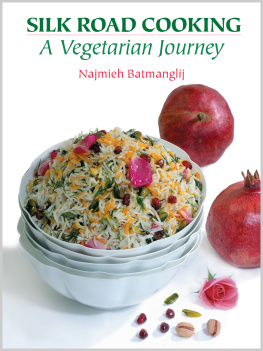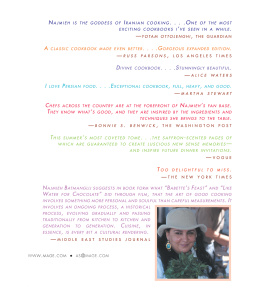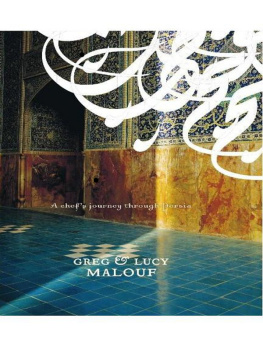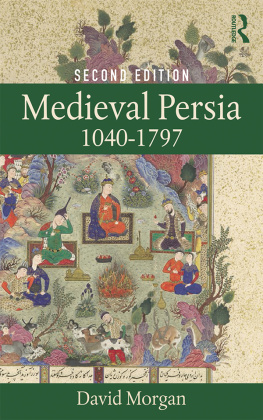NAJMIEH K. BATMANGLIJ
Copyright 2010 Najmieh Batmanglij
All rights reserved.
No part of this book may be reproduced
or retransmitted in any manner whatsoever,
except in the form of a review, without the
written permission of the publisher.
LIBRARY OF CONGRESS CATALOGING-IN-PUBLICATION DATA
Batmanglij, Najmieh.
A taste of Persia: an introduction to Persian cooking
Najmieh K. Batmanglij. 2nd ed.
p. cm.
Includes index.
ISBN 0-933823-13-5 (alk. paper)
Cookery, Iranian.
I. Title
TX725.I7B377 2007
641.5'955 dc22
2006028312
Digital Edition
ISBN 978-1933823-42-3
Mage books are available at bookstores or directly from the publisher.
To receive our latest catalog, call toll free 1-800-962-0922
or visit Mage online at www.mage.com .
PREFACE
ALTHOUGH I HAVE SIMPLIFIED the steps for the recipes in this book, they nonetheless represent thousands of years of development, reflecting the skills and passions of countless generations of Iranian cooks.
In all eras, Iranians have known that the secret to good food is the quality of the seasonal ingredients you begin with. The ideal is to proceed straight from the garden to the kitchen, but, since that is not usually possible, go to the next best thing: local farmers' markets selling produce that was not picked weeks or months ago. After that, there is one other essential ingredient: the feeling that you bring to cooking. For a meal to really taste good and to be nourishing in the deepest sense, it must be made with love.
Years ago when I left Iran to study abroad, I longed for a meal with Persian flavors and the aromas of fresh ingredients such as autumn-perfumed dill, baby garlic and fava beans combined with long-grained rice. The ingredients were not easy to find then, but today they are widely available not only in Persian and ethnic grocery stores but also in local supermarkets. I am also delighted by the sight of all the leafy greens, aromatic herbs, and luscious, ripe fruit at the many exciting fresh farm markets around the country where farmers are selling organic vegetables, eggs and even meats. Often these farmers are adventurous in their tastes and willing to experiment. For example, Mark, a young farmer at my local market, was inspired by one of my books to grow the tiny, crunchy, exquisite, bright-green, seedless Persian cucumbers as well as the sweet and tender, lemony-tasting Persian basil, and the fresh perfumed fenugreek that gives the unique flavor and aroma in the renowned Iranian fresh herb braise Qormeh Sabzi.
A Taste of Persia is intended as an introduction to Persian cooking. For the present edition, I have updated some of the recipes and also added a number of new photographs showing what the finished dishes might look like. The recipes contain many shortcuts so that they are quicker to make and more compatible with our contemporary, fast-paced lifestyle. I remember how, as a young mother and wife living in exile with ambitions of a career, I could not afford to spend more than an hour in the kitchen every day to prepare a meal for the family. Most of the recipes in this book take less than an hour to make, but they remain faithful to the authenticity and the Persianness of the flavors; I hope you will be inspired to try many of them. Nush-e Jan!

TABLE OF CONTENTS
INTRODUCTION
This book is an invitation to the world's other ancient cuisine. Persia's cookery, like China's, has had thousands of years of change and refinement, but it still retains roots in its ancient sources. As a matter of fact, you know more about Persian food than you might think. When you ask for oranges, pistachios, spinach, or saffron, you are using words derived from the Persian that refer to foods either originating in the region or introduced from there, for Persia was a great entrept of the ancient and medieval worlds. The land was the first home of many common herbs, from basil to coriander, and to scores of familiar preparations, including sweet and sour sauces, kababs, and almond pastries.
Such preparations are most delicious in their original forms, which you will find in the recipes in this book. All the recipes come from the land Europeans have long called Persia. That name is the Hellenized form of Pars, the southwestern province that was the homeland of the rulers of the first Persian empire. They, however, called themselves Iranians and their country Iran, words derived from Aryan, the name of their ancestral tribes. Nowadays the words are used interchangeably. They describe a people whose civilization and cuisine are ancient indeed.
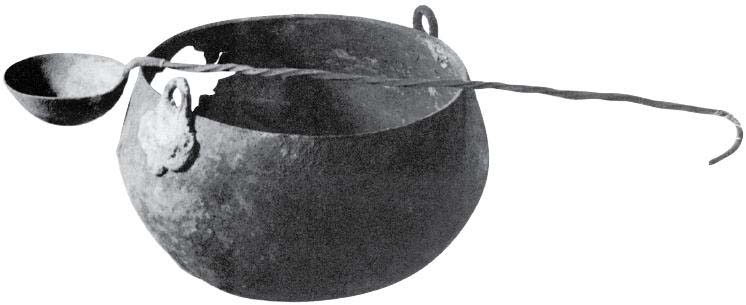

A FEW THOUSAND YEARS AT A GLANCE
By 1000 BCE , when the Indo-Aryan tribes called the Medes and the Persians first settled the highlands of the Iranian plateau, the region had been home to great civilizations for thousands of years. In Iran itself, kingdoms had risen and fallen. Among them was the mysterious and widespread civilization whose kings were buried in elaborate tombs at Marlik, near the Caspian Sea, in the second millennium BCE . The people of Marlik produced splendid jewelry, armor, and tools; their gold and silver eating and drinking vessels often displayed the animal motif that remained part of the Iranian tradition. And the styles of their everyday kitchen equipmentsome of which is shown on these pagesare echoed in the region today.

